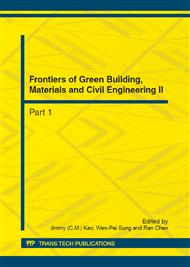p.925
p.931
p.935
p.939
p.949
p.954
p.958
p.964
p.970
Nonstationary Probabilistic Seismic Response Analysis of Nonlinear Soil Profile under Bidirectional Dynamic Loading
Abstract:
In this paper, according to the characteristics of near-fault earthquakes, combined with the strong ground motion attenuation law in China, the nonstationary power spectrum of bidirectional ground motion input is obtained through random vibration analysis. By introducing the pseudo excitation algorithm, the evolutionary power spectral density (PSD) of acceleration at the engineering bedrock is handled as the nonstationary pseudo input, and the Hardin-Drnevich hyperbolic model is utilized to take into account the nonlinearity of soil layer. On this basis, finite element method in the time domain and frequency domain are used for seismic response analysis of soil profile. Values including various time-varying power spectral density of the dynamic response, time varying RMS and time-dependent reliability at different threshold can be obtained by calculating, which provides a basis for the analysis of the foundation dynamic reliability assessment.
Info:
Periodical:
Pages:
949-953
Citation:
Online since:
August 2012
Authors:
Price:
Сopyright:
© 2012 Trans Tech Publications Ltd. All Rights Reserved
Share:
Citation:


